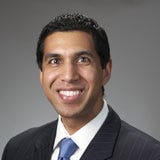I am excited about new endovascular technology allowing vascular surgeons to treat tibial artery disease. The tibial vascular bed remains a challenging location to treat and contributes to a significant number of lower extremity amputations. San Antonio has one of the largest diabetic populations, at 14%. If a new device allowed the efficacious treatment of tibial peripheral arterial disease, the diabetic amputation rate could be addressed.
—Lyssa Ochoa, MD, vascular surgeon in San Antonio, TX | |
Electronic anesthesia records. This is something that can provide a complete billing for what we’ve used. The hospital coders can take this and use it for their billing as well. We’re looking at increased revenue for the work that we’ve done by being able to have error tracking and have the software ensure the completeness of our documentation. We should be able to capture additional revenue that we currently are not simply by inadequate documentation in our paper record. It’s showing value to everyone along the way.
—Maneesh Amancharla, MD, anesthesiologist and partner
at Capitol Anesthesiology Association in Austin, TX | |
Wireless technologies for surgical instruments. Covidien’s wireless harmonic has really facilitated how I operate. Wireless cameras would be good as well. Right now it is too cumbersome in the OR with all the tubes, cables, and cords—suction, gas, cameras, etc.
—Marlon Guerrero, MD, Director of Endocrine Surgery and Assistant Professor of Surgery at the University of Arizona
| |
A rapid molecular test that could identify specific pathogens without requiring heat or enzymatic activity would lead to faster, more cost effective diagnostic alternatives and facilitate pathogen-directed therapies.
—Robert Sambursky, MD, cornea specialist with Manatee Sarasota Eye Clinic and Laser Center in Sarasota, FL | |
There’s a portable extracorporal membrane oxygenation device that Maquet manufactures called Cardiohelp. So this is [an] example of an old technology that’s become portable and so much better. The old technology is the heart-lung bypass machines that were used in the '50s, '60s. But it’s a very clunky, high-risk kind of tool that’s become better over time. Now they make those machines, they are super efficient and super cool. They don’t have as much bleeding risk and [are] much easier to place. They are for patients who need respiratory and circulatory support for a long period of time.
—Sumanth Ambur, MD, emergency medicine physician and critical-care fellow at Hennepin County Medical Center in Minneapolis | |
Continuous transesophageal echocardiography. The ultrasound probes are smaller [and] can remain in the esophagus for several days. This may solve some of the problems with resuscitation and cardiovascular function in critically ill patients. I think it will be the new Swan-Ganz catheter, only better at measuring actual stroke volume and cardiac output. It’s a very new way to look at an old problem with existing technology.
—Thomas Granchi, MD, director of the Burn Treatment Center and clinical professor of surgery at the University of Iowa | |









